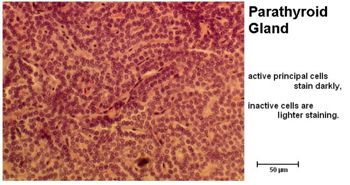Parathyroid Glands - Anatomy & Physiology
Anatomy
The parathyroid glands are multiple (generally four) small glands, approximately 1-2mm in length are located about the cranial trachea. Generally, there are two internal glands embedded within the thyroid Glands, and two external glands are outside the thyroid tissue. However, all of the parathyroid tissue may be embedded within the thyroid gland itself. In the horse, there are 'nests' of parathyroid tissue along the neck to the thoracic inlet.
Embryology
The parathyroid glands originate from the endoderm of pharyngeal pouches III and IV. The internal gland from pouch IV and the external from pouch III.
Histology
The parathyroids are histologically easy to distinguish from the thyroid.
The thyroid has a characteristic follicular structure, whereas the parathyroid consists of densely packed cells, of two types:
1. Chief cells (Principal Cells)
These are the predominant cell type. They stain darker when they are active and are smaller than oxyphil cells. They manufacture Parathyroid Hormone (PTH).
2. Oxyphil cells
Oxyphil cells are fewer in number than chief cells. They stain lighter and are larger than chief cells. They have an unknown function.
Grossly, the parathyroids are difficult to differentiate from thyroid tissue or fat. A parathyroid gland may be accidentally removed during thyroidectomy. Care must therefore be taken if the second thyroid is removed to leave the parathyroid intact, otherwise hypoparathyroidism may ensue.
Histology Gallery
Blood Supply and Innervation
| Arteries | Veins | Nerve | Precursor |
|---|---|---|---|
| Superior thyroid artery | Superior thyroid vein | Middle cervical ganglion | Neural crest mesenchyme |
| Inferior thyroid artery | Middle thyroid vein | Inferior cervical ganglion | 3rd and 4th pharyngeal pouch endoderm |
| .</white> | Inferior thyroid vein | .</white> | .</white> |
Physiology
The sole function of the parathyroid gland is to maintain calcium homeostasis. Calcium homeostasis is, amongst other things, important for maintaining the function of the nervous and muscular systems. When blood calcium levels drop below a certain point, calcium-sensing receptors in the parathyroid gland are activated to release hormone into the blood. The hormone produced by the parathyroid gland (Parathyroid Hormone) also has an effect on phosphorus homeostasis.
| Parathyroid Glands - Anatomy & Physiology Learning Resources | |
|---|---|
 Test your knowledge using flashcard type questions |
Parathyroid glands |
 Selection of relevant PowerPoint tutorials |
Histology of the Endocrine system |
Error in widget FBRecommend: unable to write file /var/www/wikivet.net/extensions/Widgets/compiled_templates/wrt6741f30898fbd7_74314142 Error in widget google+: unable to write file /var/www/wikivet.net/extensions/Widgets/compiled_templates/wrt6741f308a7bcb1_83833207 Error in widget TwitterTweet: unable to write file /var/www/wikivet.net/extensions/Widgets/compiled_templates/wrt6741f308b93072_69217837
|
| WikiVet® Introduction - Help WikiVet - Report a Problem |




